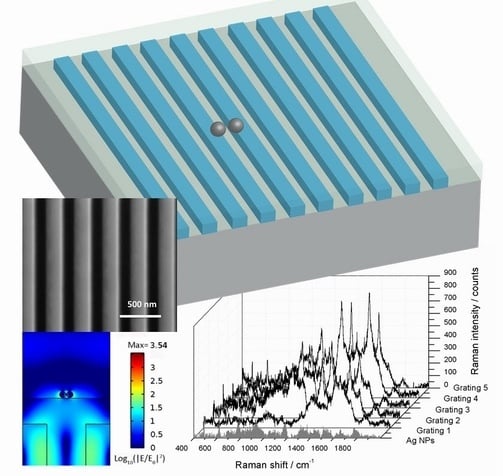Guided-Mode Resonance Grating with Self-Assembled Silver Nanoparticles for Surface-Enhanced Raman Scattering Spectroscopy
Abstract
:1. Introduction
2. Experimental Section
2.1. Reagents and Materials
2.2. ITO GMR Grating Fabrication

2.3. Silver Nanoparticle Synthesis and Self-Assembling
2.4. Instrumentation
3. Results and Discussion
3.1. Design and Characterization of the Medium Q-Factor ITO Grating


3.2. Numerical Investigation of the Optical Coupling between Ag NPs and the ITO Grating


3.3. SERS Sensing with the Ag NPs on ITO Gratings


4. Conclusions
Acknowledgments
Author Contributions
Conflict of Interest
References
- Li, J.F.; Huang, Y.F.; Ding, Y.; Yang, Z.L.; Li, S.B.; Zhou, X.S.; Fan, F.R.; Zhang, W.; Zhou, Z.Y.; Wu, D.Y.; et al. Shell-isolated nanoparticle-enhanced raman spectroscopy. Nature 2010, 464, 392–395. [Google Scholar]
- Nie, S.M.; Emery, S.R. Probing single molecules and single nanoparticles by surface-enhanced raman scattering. Science 1997, 275, 1102–1106. [Google Scholar] [CrossRef] [PubMed]
- Kneipp, K.; Wang, Y.; Kneipp, H.; Perelman, L.T.; Itzkan, I.; Dasari, R.; Feld, M.S. Single molecule detection using surface-enhanced raman scattering (sers). Phys. Rev. Lett. 1997, 78, 1667–1670. [Google Scholar] [CrossRef]
- Kneipp, K.; Kneipp, H.; Kartha, V.B.; Manoharan, R.; Deinum, G.; Itzkan, I.; Dasari, R.R.; Feld, M.S. Detection and identification of a single DNA base molecule using surface-enhanced raman scattering (sers). Phys. Rev. E 1998, 57, R6281–R6284. [Google Scholar] [CrossRef]
- Stranahan, S.M.; Willets, K.A. Super-resolution optical imaging of single-molecule sers hot spots. Nano Lett. 2010, 10, 3777–3784. [Google Scholar] [CrossRef] [PubMed]
- Jiang, J.; Bosnick, K.; Maillard, M.; Brus, L. Single molecule raman spectroscopy at the junctions of large ag nanocrystals. J. Phys. Chem. B 2003, 107, 9964–9972. [Google Scholar] [CrossRef]
- Lim, D.K.; Jeon, K.S.; Kim, H.M.; Nam, J.M.; Suh, Y.D. Nanogap-engineerable raman-active nanodumbbells for single-molecule detection. Nat. Mater. 2010, 9, 60–67. [Google Scholar] [CrossRef] [PubMed]
- Ebbesen, T.W.; Lezec, H.J.; Ghaemi, H.F.; Thio, T.; Wolff, P.A. Extraordinary optical transmission through sub-wavelength hole arrays. Nature 1998, 391, 667–669. [Google Scholar] [CrossRef]
- Brolo, A.G.; Arctander, E.; Gordon, R.; Leathem, B.; Kavanagh, K.L. Nanohole-enhanced raman scattering. Nano Lett. 2004, 4, 2015–2018. [Google Scholar] [CrossRef]
- Hu, M.; Ou, F.S.; Wu, W.; Naumov, I.; Li, X.M.; Bratkovsky, A.M.; Williams, R.S.; Li, Z.Y. Gold nanofingers for molecule trapping and detection. J. Am. Chem. Soc. 2010, 132, 12820–12822. [Google Scholar] [CrossRef] [PubMed]
- Hu, M.; Fattal, D.; Li, J.J.; Li, X.M.; Li, Z.Y.; Williams, R.S. Optical properties of sub-wavelength dielectric gratings and their application for surface-enhanced raman scattering. Appl. Phys. A 2011, 105, 261–266. [Google Scholar] [CrossRef]
- Li, J.J.; Fattal, D.; Li, Z.Y. Plasmonic optical antennas on dielectric gratings with high field enhancement for surface enhanced raman spectroscopy. Appl. Phys. Lett. 2009. [Google Scholar] [CrossRef]
- Kim, S.M.; Zhang, W.; Cunningham, B.T. Coupling discrete metal nanoparticles to photonic crystal surface resonant modes and application to raman spectroscopy. Opt. Exp. 2010, 18, 4300–4309. [Google Scholar] [CrossRef]
- Karagodsky, V.; Tran, T.-T.; Wu, M.; Chang-Hasnain, C.J. Double-Resonant Enhancement of Surface Enhanced Raman Scattering Using High Contrast Grating Resonators. In Proceedings of the CLEO: Science and Innovations, Baltimore, MD, USA, 1–6 May 2011.
- Xu, X.B.; Hasan, D.H.; Wang, L.; Chakravarty, S.; Chen, R.T.; Fan, D.L.; Wang, A.X. Guided-mode-resonance-coupled plasmonic-active SiO2 nanotubes for surface enhanced raman spectroscopy. Appl. Phys. Lett. 2012, 100, 191114:1–191114:5. [Google Scholar]
- Ren, F.H.; Campbell, J.; Wang, X.Y.; Rorrer, G.L.; Wang, A.X. Enhancing surface plasmon resonances of metallic nanoparticles by diatom biosilica. Opt. Exp. 2013, 21, 15308–15313. [Google Scholar] [CrossRef]
- Yang, J.; Ren, F.; Zhen, L.; Campbell, J.; Rorrer, G.L.; Wang, A.X. Surface-Enhanced Raman Scattering Immuno-Assay Using Diatom Frustules. In Proceeding of the CLEO: Science and Innovations, San Jose, CA, USA, 8–13 June 2014.
- Stokes, R.J.; McBride, E.; Wilson, C.G.; Girkin, J.M.; Smith, W.E.; Graham, D. Surface-enhanced raman scattering spectroscopy as a sensitive and selective technique for the detection of folic acid in water and human serum. Appl. Spectrosc. 2008, 62, 371–376. [Google Scholar] [CrossRef] [PubMed]
- Granqvist, C.G.; Hultåker, A. Transparent and conducting ITO films: New developments and applications. Thin Solid Films 2002, 411, 1–5. [Google Scholar] [CrossRef]
- Wang, Z.Y.; Zong, S.F.; Chen, H.; Wu, H.; Cui, Y.P. Silica coated gold nanoaggregates prepared by reverse microemulsion method: Dual mode probes for multiplex immunoassay using sers and fluorescence. Talanta 2011, 86, 170–177. [Google Scholar] [CrossRef] [PubMed]
© 2014 by the authors; licensee MDPI, Basel, Switzerland. This article is an open access article distributed under the terms and conditions of the Creative Commons Attribution license (http://creativecommons.org/licenses/by/4.0/).
Share and Cite
Yang, J.; Ren, F.; Chong, X.; Fan, D.; Chakravarty, S.; Wang, Z.; Chen, R.T.; Wang, A.X. Guided-Mode Resonance Grating with Self-Assembled Silver Nanoparticles for Surface-Enhanced Raman Scattering Spectroscopy. Photonics 2014, 1, 380-389. https://doi.org/10.3390/photonics1040380
Yang J, Ren F, Chong X, Fan D, Chakravarty S, Wang Z, Chen RT, Wang AX. Guided-Mode Resonance Grating with Self-Assembled Silver Nanoparticles for Surface-Enhanced Raman Scattering Spectroscopy. Photonics. 2014; 1(4):380-389. https://doi.org/10.3390/photonics1040380
Chicago/Turabian StyleYang, Jing, Fanghui Ren, Xinyuan Chong, Donglei Fan, Swapnajit Chakravarty, Zheng Wang, Ray T. Chen, and Alan X. Wang. 2014. "Guided-Mode Resonance Grating with Self-Assembled Silver Nanoparticles for Surface-Enhanced Raman Scattering Spectroscopy" Photonics 1, no. 4: 380-389. https://doi.org/10.3390/photonics1040380
APA StyleYang, J., Ren, F., Chong, X., Fan, D., Chakravarty, S., Wang, Z., Chen, R. T., & Wang, A. X. (2014). Guided-Mode Resonance Grating with Self-Assembled Silver Nanoparticles for Surface-Enhanced Raman Scattering Spectroscopy. Photonics, 1(4), 380-389. https://doi.org/10.3390/photonics1040380






